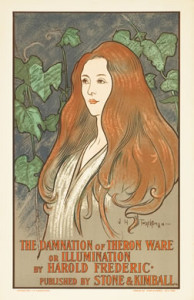
Personally, I love good novels. Who doesn’t? They do, however, present all kinds of problems as teaching devices–authorial perspective, literary affectations, introducing themes you haven’t prepared students for. But when a novel hits, it usually hits hard.
I had a banner experience this past week with Harold Frederic’s classic book The Damnation of Theron Ware, or Illumination.
For one thing, the students loved it. At 340+ pages, it’s quite likely the longest book many of them have read. Plus, they only had two weeks to get through it (three if you count when the paper is due–tomorrow!). In the middle of the two weeks, during a Friday session, I got them through the first 50 pages–we read sections together, we talked about who the central characters were and what they were experiencing, we discussed what themes they recognized from my lectures. But that was it.
My hope was that they now had solid grounding to get through the rest of the book, with professorial ambitions that the 50-page hand-holding would propel them into the rest of the novel, which would generate it’s own energy to keep those pages turning.
I was skeptical on due date about how many of them would have finished, but a huge number had, and they were already debating it when I walked into the classroom. I always spend 10 minutes or so going over the basics of the plot (“…and then what happened?”), to make sure everyone is on board. During this particular discussion, though, when we approached the end of the book, there were two or three students who loudly said “no!” and covered their ears so as not to spoil the ending. They had 30 or so pages left. For their sake we left things vague.
On their own, they brought out the major themes I had gone over in class–19th-century Catholic immigration, the importance of biblical higher criticism and Darwin to the de-centering of the Protestant mainstream, the various responses coming from America’s Protestants. By the time the 50 minutes were up, students still had a lot to say. We hadn’t even gone over the meaning of the title and the idea that the characters were symbols of larger things going on in the country. The following session the students forcibly brought back the conversation. One student did an Icarus impression. Another talked about her own shapely red-headed sister. It was great. Someone learned that the letters of the beguiling, red-headed Irish-Catholic Celia Madden are an anagram for “Alice damned,” referring to Theron’s thoroughly domesticated, thoroughly Protestant wife.
Emails kept pouring in through the week. It all just makes a professor proud.
I don’t think any academic book I’ve assigned has engendered similar enthusiasm, even Ed’s great books, which are well worth assigning. But I have had luck with other novels: Studs Lonigan is often a hit, Blackrobe has worked, The Great Gatsby is still an all-time favorite.
What novels have worked for you? I’d love to know.




“Damnation” is absolutely my favorite novel to use as a teaching tool. It works so well, on so many levels.
Other novels/writings which have worked well:
Washington Irving, “Rip Van Winkle”
Nathaniel Hawthorne (he’s got some great short stories, like “My Kinsman, Major Molineaux” and “Young Goodman Brown.” These tend to work better than his novels in history classes)
E.L. Doctorow, “Ragtime”
John Steinbeck, “Travels with Charley”
My books always go over well with my students (but then they read Tri-Faith and wish I had written that! More seriously, I’ve also heard of some folks using ‘children’s novels’ to teach with – such as Little House on the Prairie. I’ve never done that, but I want to try it. For the first half of US history, there are wonderful pamphlets for religious education that could get students into the period. Not exactly novels, though, and I’ve yet to meet a student who enjoyed _Uncle Tom’s Cabin_
Really Ed, _Uncle Tom’s Cabin_ didn’t work? I had good luck with it once, but that was when I was in graduate school. All that melodrama…
And Brian, thanks for these. How does _Ragtime_ work? It’s got to be problematic in the fact that it’s a historical novel bound up by all these misrepresentations of race and class. It has been a while since I’ve read it, but I’m dying to hear how you use it. I like the _Rip_ and Hawthorne suggestions too. Good ideas. And again, I’d love to hear how _Travels with Charley_ goes? Do they stop reading after the big storm in the beginning?
Another title I’ve had great success with: Horatio Alger’s _Ragged Dick_.
Not a novel, but a play: “Angels in America” has been a huge hit with my students, as well as allowing us to address a lot of major themes.
Speaking of plays, there are some riveting anti-lynching plays from the early twentieth century collected in _Strange Fruit_ edited by Kathy A. Perkins and Judith L. Stephens. I have not tried them in class, but that would be interesting too (many of them are short).
Angels is pretty thick, but really well done. Catherine, how do you set it up (I imagine its for the 1980s section of the class?)? Do you teach students to read plays, or do they know how?
And Ed, speaking of Strange Fruit, have you tried Lillian Smith’s version for the 1940s? I haven’t, but I loved the book.
Let’s not forget the literary gem, “Reforging the White Republic”!